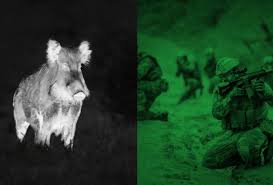Thermal Scopes vs Night Vision: A Detailed Comparison

When it comes to advanced optics for hunting, tactical operations, or security purposes, two primary technologies stand out: thermal scopes and night vision. Both offer unique capabilities, but choosing between them can be challenging. Understanding their differences, advantages, and limitations will help you make an informed decision based on your specific needs.
What is a Thermal Scope?
Thermal scopes detect infrared radiation (heat) emitted by objects and convert it into an image. This technology does not rely on ambient light, making it highly effective in total darkness. Thermal scopes are ideal for detecting heat signatures, such as animals, people, or vehicles, even through dense fog, smoke, or other challenging environmental conditions.
How Thermal Scopes Work: Thermal cameras capture the infrared radiation emitted by all objects based on their temperature. Hot objects appear bright, while cooler objects appear dark or less noticeable. This stark contrast allows users to easily spot targets regardless of the lighting conditions.
What is Night Vision?
Night vision devices, on the other hand, work by amplifying existing ambient light, such as moonlight or starlight, to create a visible image. They do not work in total darkness and are limited to environments where there is at least some light present. Night vision devices are commonly used in military, law enforcement, and recreational activities like hunting or surveillance.
How Night Vision Works: Night vision technology uses an image intensifier tube to amplify low levels of light. The tube converts photons into electrons, which are then amplified and projected onto a phosphor screen. This process creates a visible image from the faintest light, allowing users to see in low-light conditions.
Key Differences Between Thermal Scopes and Night Vision
Detection Capability:
The most significant difference between thermal scopes and night vision is how they detect objects. Thermal scopes identify heat signatures, making them capable of seeing through obstacles like smoke, fog, or camouflage. Night vision relies on visible light, so it works only in dimly lit environments.
Image Quality and Clarity:
Thermal scopes provide a more straightforward, clearer image when it comes to identifying heat signatures, especially in low visibility situations. However, they often produce less detailed images compared to night vision scopes. Night vision offers a more defined image but is limited to environments with at least some light.
Environmental Performance:
Thermal scopes outperform night vision in challenging weather conditions. They can detect warm objects in environments with zero light, such as during night-time operations, foggy conditions, or heavy rain. Night vision devices, on the other hand, depend on some light source and can struggle in adverse conditions like rain, fog, or complete darkness.
Advantages of Thermal Scopes
- All-Weather Usability: Thermal scopes can be used day or night and in various weather conditions.
- Detection of Hidden Targets: Thermal optics can detect living creatures even if they are hidden behind foliage, structures, or other obstructions.
- No Need for External Light: They function independently of ambient light, making them ideal for use in total darkness.
Advantages of Night Vision
- Sharper Images in Low Light: Night vision provides clearer, more detailed images in dim light environments compared to thermal.
- Longer Battery Life: Night vision devices typically use less power than thermal scopes, offering longer operational time on a single charge.
- Lower Cost: Night vision technology is generally more affordable than thermal scopes.
Disadvantages of Thermal Scopes
- Lower Image Detail: While they excel at detecting heat signatures, thermal scopes often lack the fine detail offered by night vision.
- Higher Cost: Thermal optics are typically more expensive than night vision systems due to their advanced technology.
- Battery Drain: Thermal scopes can consume more battery power, especially during extended use.
Disadvantages of Night Vision
- Limited in Total Darkness: Night vision requires at least some light to work, making it ineffective in complete darkness.
- Susceptible to Weather Conditions: Night vision can struggle in fog, rain, or other poor weather conditions.
- Potential for Image Distortion: In very low light, night vision can sometimes create a grainy or blurry image.
Thermal Scopes vs Night Vision: Which is Better for You?
Choosing between a thermal scope and a night vision device depends largely on your intended use. Here are some factors to consider:
Hunting: If you’re hunting at night, especially in thick vegetation or challenging weather, a thermal scope may be the better choice. Its ability to detect heat signatures through obstacles is a significant advantage. However, if you’re hunting in clear conditions with some ambient light, night vision could provide a more detailed view.
Tactical Operations: For military or law enforcement applications, thermal scopes are often preferred due to their ability to detect hidden targets in low visibility conditions. Night vision can still be useful, especially for clear, low-light environments where sharp image clarity is needed.
Surveillance: For security and surveillance purposes, a thermal scope may be ideal for detecting intruders at night or in low-light conditions. Night vision could be useful for monitoring in areas with some existing light, such as streetlights or moonlit areas.
Conclusion: Thermal Scopes vs Night Vision
Thermal scopes and night vision devices each have their strengths and weaknesses. Thermal scopes are excellent for all-weather, all-environment use, offering superior performance in complete darkness and through obstructions. Night vision, on the other hand, provides a clearer image in low-light environments and tends to be more affordable and energy-efficient. Understanding the key differences between these technologies is essential for choosing the right one based on your needs.



